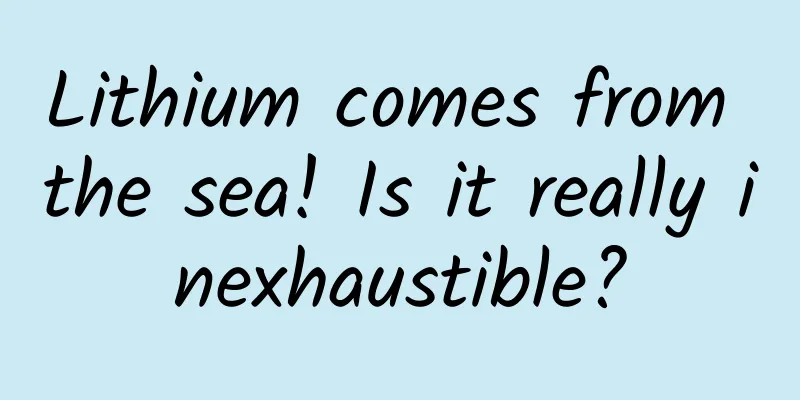Lithium comes from the sea! Is it really inexhaustible?

|
Produced by: Science Popularization China Author: Zhou Hongchang (University of Tokyo) Producer: China Science Expo Lithium, as an important battery resource, is familiar to everyone. Whether it is a pacemaker that saves lives or a tablet, mobile phone, or computer used for work and study, lithium batteries are needed. Lithium has become an indispensable material in people's lives, and how to better develop lithium resources has become a concern for everyone. At present, my country mainly extracts lithium from ores and salt lakes, but in fact, we are guarding a lithium reservoir that is yet to be developed - the ocean. For a long time, research on extracting lithium from seawater has been hot, but it has not been industrialized. Recently, Qingdao held a signing ceremony for the world's first seawater desalination brine lithium extraction cooperation project, officially launching the construction of the world's first seawater lithium extraction project, marking a new stage in the transition of seawater lithium extraction from engineering verification to industrialization. From the current situation of lithium resource development industry, what is the prospect of this project? Compared with the existing various lithium resource utilization methods, what are the advantages and disadvantages of seawater lithium extraction? This article will answer the questions about lithium for you. Qingdao holds signing ceremony for world's first seawater desalination and brine lithium extraction cooperation project (Photo source: Qingdao News Network) The existing lithium resource development method is still the long-term protagonist Lithium is a core element in the new energy industry and is widely used in high-tech fields such as lithium-ion batteries. Existing lithium resource development is mainly concentrated in two types of mineral resources: spodumene ore (hard rock ore) and salt lake brine. Lithium in hard rock ores mainly exists in the form of spodumene ore. The development process usually includes ore mining, ore crushing, grinding, flotation and smelting. The main lithium extraction methods are acid leaching and roasting. Three types of spodumene crystals (Image source: Wikipedia) Acid leaching of lithium is to mix the crushed and ground spodumene ore with sulfuric acid to generate soluble lithium sulfate, and then extract lithium through solid-liquid separation, concentration, crystallization and other processes. The roasting method is to mix spodumene ore with soda ash or gypsum, roast it at high temperature to generate water-soluble lithium salt, and then extract lithium through water leaching, filtration, crystallization and other processes. Some of the world's major lithium deposits, such as Australia's Greenbushes mine and China's spodumene mine, contain up to 1% to 2% lithium. The development and refining processes of these deposits are relatively mature and have considerable output. On the other hand, salt lake brine is a lithium-rich groundwater resource. The main methods for extracting lithium from salt lake brine are solar evaporation and ion exchange. Uyuni Salt Flats (Image source: Wikipedia Author: Dan Lundberg) The solar evaporation method is to pump salt lake brine into a large evaporation pond and use solar energy to evaporate the water in it, so that the lithium concentration gradually increases. After evaporation in a series of evaporation ponds, when the lithium concentration in the liquid reaches a certain level, lithium extraction and refining are carried out. The ion exchange method is to separate lithium ions from salt lake brine through ion exchange resins or membranes. The advantage of this method is that it has high selectivity, but the processing capacity is limited by the performance of the resin or membrane. The lithium concentration in salt lake brine is usually between several hundred and several thousand mg/L, which is lower than that of hard rock mines, but the output is still relatively high because surface salt lake resources are easy to mine and process. South American salt lakes, such as the large number of salt lakes at the junction of Argentina, Chile and Bolivia, are an important source of global lithium resources. In general, the two methods have their own advantages and disadvantages. The advantage of the hard rock mining method is that it has a higher production capacity, but it causes greater damage to the environment; while the salt lake brine development method is relatively environmentally friendly, but it is greatly affected by climatic conditions and has a lower lithium recovery rate. In recent years, the global demand for lithium has continued to grow, and the price of lithium raw materials has remained high for a long time, which has caused considerable cost pressure on battery manufacturers and new energy vehicle companies downstream of the industrial chain. Therefore, people have focused on the research of extracting lithium from seawater. After all, the total amount of lithium resources in the ocean is abundant and can be described as inexhaustible. The amount of lithium resources in seawater is about 230 billion tons, which is 16,000 times the total amount of lithium resources that can be mined in the world. However, the lithium concentration in seawater is very low, generally between 0.1 and 0.2 mg/L, which is about one hundred thousandth of the lithium content in ore. Due to low concentration, technical difficulty and cost issues, the current production efficiency of extracting lithium from seawater is far lower than the existing lithium resource development technology. Therefore, the existing lithium resource development method remains the long-term protagonist. The ocean's lithium reserves are as high as 230 billion tons (this picture shows Amami Oshima) (Photo credit: Photo taken by the author) It is true that it is inexhaustible, but production efficiency is a big problem The technology of extracting lithium from seawater is still in the research and development stage. The technical routes mainly include adsorption, ion exchange, electrochemical method and solvent extraction. Next, let's take a look at the differences between these methods: Adsorption method: Lithium ions are adsorbed from seawater using specific adsorbents, such as lithium ion exchange materials or lithium ion sieves, and then desorbed from the adsorbent by appropriate desorbents, thereby achieving lithium enrichment and recovery. The advantages of this method are simple operation and environmental friendliness, but the disadvantages are that the lithium recovery rate and selectivity are limited by the performance of the adsorbent. The ion exchange method is the same as that of salt lake brine, and has the same advantages and disadvantages. In addition, the ion exchange resin needs to be regenerated regularly during use, which increases the complexity of the operation. The electrochemical method mainly uses the principle of electrolysis or electrophoresis to extract lithium from seawater. The advantage of the electrochemical method is that it has high selectivity, but the disadvantage is that it consumes a lot of energy and has high equipment costs. In addition, certain by-products may be produced during the electrolysis process, which need to be treated. Solvent extraction is a method of separating lithium from seawater by forming a complex with lithium ions using a specific organic solvent or complexing agent. The advantage of this method is its high selectivity, but its disadvantage is that it uses organic solvents, which have a certain impact on the environment. In addition, the process of solvent recovery and regeneration is relatively complicated. Lithium batteries used in smartphones (Image source: Wikipedia Author: MyXyloto) Although the technology has problems, the prospects for industrialization are not bleak. The key factor in developing the industrialization of seawater lithium is to reduce the mining cost. Whether it can reach the level of existing technology depends mainly on the following points. The first is naturally technological progress. In the next few years, with the continuous research and development of related technologies, extraction efficiency may be improved and costs may be reduced. On this basis, as the world's attention to sustainable energy continues to increase, governments may provide policy support and financial investment in this field. At the same time, market demand is also an important influencing factor. With the rapid development of the electric vehicle and renewable energy markets, the demand for lithium resources will continue to grow, which will provide market impetus for the industrial development of lithium extraction from seawater. Moreover, compared with traditional lithium resource mining technology, the environmental impact of extracting lithium from seawater is expected to be smaller. In the context of emphasizing sustainable development, this is also an important driving force for industrialization. Lithium metal floating on kerosene (Image source: Wikipedia) Conclusion In summary, the existing lithium resource development technology is still significantly superior to extracting lithium from seawater in terms of yield. As technology advances and the demand for sustainable energy increases, this technology may be improved and developed to increase yield and competitiveness. According to Qingdao News, the newly built project uses the concentrated brine produced by Qingdao Baifa Seawater Desalination Plant to extract lithium before discharge, and can produce about 40 tons of lithium carbonate per year. Regardless of whether the future development of this project is smooth sailing, as an important attempt in the global lithium resource development industry, it will be recorded in the global industrial history. Relying on more and more technological innovations, perhaps one day in the future, we can confidently say: "Lithium is free!" Editor: Sun Chenyu |
<<: “Crying” can cure diseases! ? It sounds outrageous, but...
>>: Are vertical lines and white spots on the nails a “signal of death”?
Recommend
An introduction to Kuwo Music advertising promotion styles and material specifications!
Kuwo Music Advertising is China's leading onl...
How many days in advance can we visit the graves during the Qingming Festival in 2022? What are the rules for visiting graves? The best time to visit graves!
The Qingming Festival holiday begins tomorrow. Du...
Basic operations of Xmind software, self-study office software tutorial!
Xmind software basic operations Chapter 1: Softwa...
Huawei's Last Mile
[[132497]] In 2014, Huawei won the crown with glo...
Opening up a new track in aviation! Chinese scientists achieve new breakthrough in aviation tire technology!
A civil aircraft soars into the blue sky, it is i...
Win10 pushes new features: make your computer faster
Computer lag is often the most headache problem f...
Discovered the magical solar system, not only has four gas giants, but also two asteroid belts
The planetary system around the star HR8799 is st...
Can dieting and losing weight "starve" tumors to death? Some people really do this, and the result is...
"You can 'starve tumors' by dieting&...
Do users uninstall the APP as soon as it is pushed? Pay attention to these 3 key points when doing push
As we all know, the cost of acquiring users is ge...
Tesla recalls 734 imported Model 3s due to risk of loose screws
According to the official website of the State Ad...
Brand Marketing: 5 Principles of Brand Naming
First, McDonald's name change to "Golden...
Experts assert that it is difficult for Internet companies to succeed in invading the white goods industry
Faced with the cross-border entry of Internet com...
Artificial intelligence is getting smarter, should we give AI human rights?
A few years ago, the topic of legal personhood an...
4 ways to pull seed users
It’s a relatively new product and I don’t think t...
The most popular iOS automation testing tools in 2022
The year-over-year growth in iOS device sales has...









